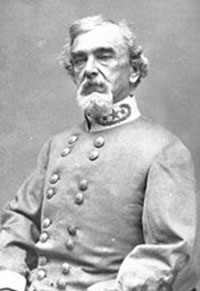Benjamin Huger (1805-1877)
Benjamin Huger (November 22, 1805 December 7, 1877) was a career U.S. Army ordnance officer and a Confederate general in the American Civil War.
 Huger was born in Charleston, South Carolina. (He pronounced his name "ooh-ZHAY", although many current Charlestonians say "OOH-gee".) His grandfather, also named Benjamin Huger, was a patriot in the American Revolution, killed at Charleston during the British occupation. Huger graduated from the U.S. Military Academy in 1825 and was commissioned a second lieutenant in the 3rd U.S. Artillery. He served as a topographical engineer until 1828, then took a leave of absence to visit Europe. Upon his return, he became an ordnance officer and spent the majority of his career at that occupation. He commanded Fortress Monroe arsenal for twelve years, and was a member of the U.S. Army Ordnance Board for seven.
Huger was born in Charleston, South Carolina. (He pronounced his name "ooh-ZHAY", although many current Charlestonians say "OOH-gee".) His grandfather, also named Benjamin Huger, was a patriot in the American Revolution, killed at Charleston during the British occupation. Huger graduated from the U.S. Military Academy in 1825 and was commissioned a second lieutenant in the 3rd U.S. Artillery. He served as a topographical engineer until 1828, then took a leave of absence to visit Europe. Upon his return, he became an ordnance officer and spent the majority of his career at that occupation. He commanded Fortress Monroe arsenal for twelve years, and was a member of the U.S. Army Ordnance Board for seven.
In the Mexican-American War, Huger was chief of ordnance on the staff of Winfield Scott, and received brevets to major, lieutenant colonel, and colonel, for gallant and meritorious conduct at Vera Cruz, Molino del Rey, and Chapultepec. In 1852 he was presented a sword by South Carolina in recognition of the honor his career had cast upon his native state. After this war he served on the board that prepared a system of artillery instruction for the army, and was in command of the armories at Harpers Ferry, Charleston, and Pikesville, Maryland
At the start of the Civil War, he was commissioned colonel of artillery in the Confederate States Army. On May 23, 1861, he was assigned to command the Department of Norfolk, with defensive responsibilities for North Carolina and southern Virginia. By October 7, 1861, he achieved the rank of major general. In May of 1862, when Union troops were approaching, Huger ordered the destruction of the Norfolk works and naval yard at Portsmouth. He dismantled the CSS Virginia ironclad and evacuated the area. While in command of Roanoke Island, he failed to reinforce his position, and his command had to surrender to the Union expeditionary force. Although the Confederate Congress investigated Huger's part in this defeat, Confederate President Jefferson Davis assigned him to division command under Gen. Joseph E. Johnston in the Army of Northern Virginia.
Huger led his division at Seven Pines and in several of the Seven Days Battles (now under the command of Robert E. Lee). He was criticized for his lackluster leadership in battles such as White Oak Swamp and Malvern Hill. Lee relieved of him duty on July 12, 1862, part of his wider purge of generals who did not meet Lee's expectations for aggressive tendencies in battle.
Following combat service on the Virginia Peninsula, Huger was assigned to be Assistant Inspector General of artillery and ordnance for the Confederate Army, and in 1863 was appointed Chief of Ordnance for the Trans-Mississippi Department. After the war, he was a farmer in North Carolina and Virginia, finally returning in poor health to his home in South Carolina.
Huger died in Charleston in 1877 and is buried in Greenmount Cemetery, Baltimore, Maryland. He was memorialized when the U.S. Army constructed "Battery Huger" inside the historic walls of Fort Sumter for the Spanish-American War.
 Huger was born in Charleston, South Carolina. (He pronounced his name "ooh-ZHAY", although many current Charlestonians say "OOH-gee".) His grandfather, also named Benjamin Huger, was a patriot in the American Revolution, killed at Charleston during the British occupation. Huger graduated from the U.S. Military Academy in 1825 and was commissioned a second lieutenant in the 3rd U.S. Artillery. He served as a topographical engineer until 1828, then took a leave of absence to visit Europe. Upon his return, he became an ordnance officer and spent the majority of his career at that occupation. He commanded Fortress Monroe arsenal for twelve years, and was a member of the U.S. Army Ordnance Board for seven.
Huger was born in Charleston, South Carolina. (He pronounced his name "ooh-ZHAY", although many current Charlestonians say "OOH-gee".) His grandfather, also named Benjamin Huger, was a patriot in the American Revolution, killed at Charleston during the British occupation. Huger graduated from the U.S. Military Academy in 1825 and was commissioned a second lieutenant in the 3rd U.S. Artillery. He served as a topographical engineer until 1828, then took a leave of absence to visit Europe. Upon his return, he became an ordnance officer and spent the majority of his career at that occupation. He commanded Fortress Monroe arsenal for twelve years, and was a member of the U.S. Army Ordnance Board for seven.